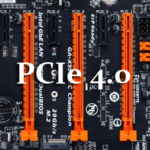New Generation PCI Express 4.0
First of all, PCI Express is also known as Peripheral Component Interconnect Express. PCI Express abbreviated officially as PCIe or PCI-e. Furthermore, PCIe is a high-speed serial computer expansion bus designed to replace PCI (a parallel bus).
PCI Express 4.0
In October 2017, the latest standard PCIe 4.0 launched. With PCIe 4.0, the speeds have increased to almost 16 Gb/s per lane. In addition, PCIe scaled up to two (x2), four (x4), eight (x8), or sixteen lanes (x16) commonly. Although standard PCIe allows up to 32 (x32) lanes. In order to allow devices to communicate with each other in real-time processing. PCIe technology with high-speed and high-efficiency transfer rates has become increasingly important in the industrial field.
Furthermore, the new generation of PCIe 4.0 specifications officially released in late 2017. PCIe 5.0 expected to launch in 2019. Moreover, PCIe bus physical layer can provide x1, x2, x8, x12, x16, and x32. Next, PCIe 4.0 encoding standard and PCIe 3.0 are 128b/130b, and the transfer rate is doubled to 16 GT/s. Therefore, PCIe can meet the increasing diversity of industrial PCs and the requirements for serial connection with other high-speed devices.
With the expansion of the industry's 4 million Internet of Things and automatic control applications. Every terminal device on the production line is becoming more intelligent, with the ability to sense, collect data, and make independent decisions and networking. Therefore, the role of the high-speed and wide-speed bus PCIe continued to be heavy, and it has long been the bus standard used by major motherboard manufacturers. Whether it is for system integrators or plant operators, PCIe modular solutions can incrementally add new features or upgrades to suit various scenarios.
DAQ - Data Acquisition

DAQ, also known as data acquisition is the process of measuring an electrical or physical phenomenon such as voltage, current, temperature, pressure, or sound with a computer. Moreover, the signal generated by the sensor read by the DAQ interface card. The DAQ interface card is a bridge between the computer and external signals. Furthermore, it can perform signal processing, digital/analog conversion, and connect to the computer.
As PCIe has developed to satisfy the need for speed in other technologies. Therefore, PCI Express becomes widely acknowledged for network cards and gaming graphic cards. However, with PCIe 3.0, it began implementation for storage on SSD which is also known as Solid State Drives. SSDs offer a much faster speed than HDDs (hard disk drives). In addition, SSDs have been in use before PCI was created. Furthermore, with PCIe, the SSD industry secured the advantage of speed. On the other hand, PCs with an SSD may have a SATA Express or SATA connection as they are usually lower cost than PCIe. However, SATA is expected to coexisting with PCIe in the industrial markets for several more years.
Acnodes Corporation has a wide array of product line configurations. They can customize most commercial and industrial computers to one’s specific needs. For information, please visit www.acnodes.com or contact us at [email protected].
About Acnodes Corporation
Acnodes manufactures, designs, and markets industrial computers and display solutions for diverse industries ranging from automation to military. We have an array of technological innovations in the area of rack mount servers, embedded computers, Panel PC’s and rugged monitors that create simpler and more valuable products to the customers. We work closely with our clients to customize computer products to meet their required projects and challenges. Acnodes strives to explore new technologies to better improve life and work.





